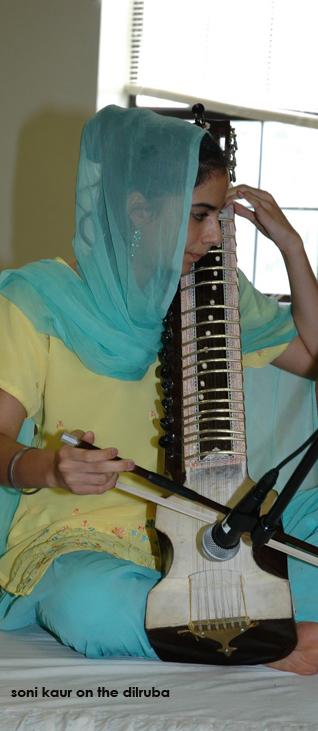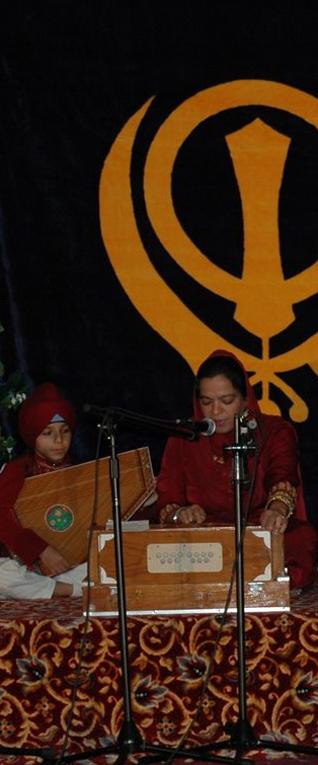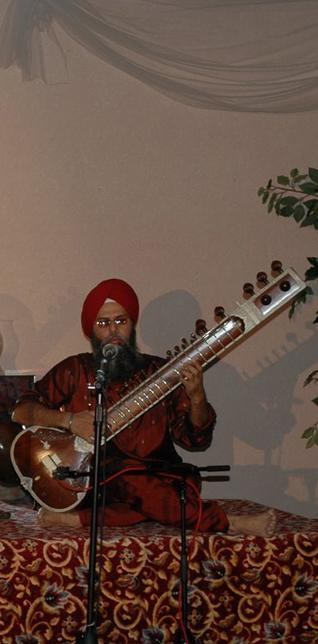Music
In Search of Intoxication
by SARBPRREET SINGH
Over the years, I have caught fleeting glimpses of an apparently brilliant, but relatively unknown figure in the world of Gurmat Sangeet. His name is Gian Singh ‘Almast'.
The name itself is intriguing! It hints at an irreverent, radical intoxication. Rebellion. Immersion.
Gian Singh Almast's personality however, remains tantalizingly obscure. He surfaces briefly when old school kirtaniyas get together and reminisce about a bygone era, but by and large he remains very elusive.
During an intimate, sparsely attended Friday evening divan at the Milford Gurdwara Sahib in 2003, Bhai Gurmeet Singh Shant is singing. The shabad is ‘Pati tore malini'. The bandish, or melody, is not the well known composition in Raga Kafi, popularized by the late Bhai Bakshish Singh, which Gurmeet Siingh Shant is known to sing. It is a dazzling, fluid, enrapturing melody in Raga Kalavati that I have never heard before.
During langar, I find myself asking Gurmeet Singh about the beautiful composition. He tells me that it was a composition by Almast ji. An outline begins to emerge! I ask Gurmeet Singh to sing more compositions by Almast. In subsequent divans, he obliges. Every composition is more beautiful than the previous one. The outline now has more definition and the essence of Gian Singh Almast's art and the sheer magnitude of his talent slowly starts to become apparent.
I go back home and frantically search through my archive of recordings by Gurmeet Singh Shant, recorded during many meetings over the years. I discover many other gems that for sure, reflect the musical genius of Almast ji.
Saturday morning in Milford. The sangat is slowly trickling in to attend a lecture-demonstration by the very talented Sikh musician, Baldeep Singh. As we wait, Baldeep Singh plays a recording of a shabad, sung in Darbari Kanada. The depth and emotion in the singing is astounding. To my ears, it is as beautiful as listening to Khan Sahib Abdul Wahid Khan, or the more contemporary Ulhas Kashalkar, sing Darbari.
I am enraptured. I ask Baldeep Singh about the singer and learn that it is none other than S. Thakar Singh, the reclusive, mysterious son of Gian Singh Almast!
Raja Mrigendra Singh, scion of the house of Patiala, is visiting Boston. He has just delivered a lecture during Vaisakhi celebrations at the Millis Gurdwara; we are in my home, chatting about various aspects of Gurmat Sangeet, particularly Sikh musicians and kirtaniyas. Raja Mrigendra Singh fondly speaks of the legendary Gajjja Singh ji and his research into Gurmat Sangeet. When I ask about Almast, I am in for a bit of a shock. He is dismissed as inconsequential, an eccentric and quirky musician.
I am puzzled, because this doesn't at all square with the portrait of Almast that is starting to emerge. A few years later, when I sit down with Gyani Dyal Singh ji to talk about Almast, I finally understand.
August 2004. The Sikh Youth Symposium has come to Boston. Among the many visitors is a family from Atlanta, very involved with kirtan. Even with all the distractions that come with organizing the event, I vividly remember their teenage daughter singing some beautiful shabads and their son being very adept on the tabla.
In August 2005, we visit Atlanta for the finals of the Symposium. It is banquet night. The family is on stage. S. Paramjit Singh Sarin plays the sitar, his daughter Soni Kaur, plays the dilruuba, Gurpreet Singh excels on the tabla and all of them including Archana Kaur sing. I wonder if my ears are deceiving me. The composition, a Guldasta or Ragmala sounds very familiar. It is indeed by Gian Singh Almast!
We congratulate S. Paramjit Singh and his family after the fine performance. We are told about the speed with which Soni Kaur has picked up the dilruba, literally in a matter of months, which I treat at first as parental pride asserting itself! The next day, the Sarins graciously host us. We sit together and share our passion about gurmat sangeet. We sing and share precious old compositions. We learn more about each other's families and their interest in gurmat sangeet.
During the conversation, I discover the secret of Soni Kaur's almost magical progress on the dilruba. Gian Singh Almast's blood runs through her veins! The speed which she picked up the dilruba is no surprise at all! Her mother, Archana Kaur, is the granddaughter of Gian Singh Almast!
It is 2006. Gyani Dyal Singh ji is visiting with us in Boston. The Gurmat Sangeet Heritage Recordings project is in full swing. Bhai Kanwarpal Singh and his jatha are also present to support and assist Gyani ji. We spend many many hours documenting gurmat sangeet compositions and gratefully drinking at the fountain of wealth of gurmat sangeet lore, that Gyani ji is!
I finally strike gold in my quest for Gian Singh Almast. Gyani ji is a contemporary of Gian Singh Almast's son, S. Thakur Singh and has known Gian Singh well, as a young man. In his inimitable style, Gyani ji holds forth talking freely and colorfully about the musical phenomenon that was Gian Singh Almast. Sometimes so colorfully that his words cannot be reproduced here!
The picture that emerges is of an unconventional, iconoclastic musical genius, with a penchant for showmanship and confidence in his musical prowess, almost bordering on arrogance. A larger than life personality with many appetites and the boldness to fully indulge in them. A composer, singer, instrumentalist and musician of incredible talent, the likes of whom has probably never been seen again in the Sikh panth. A genius who lived life to the fullest and left the world, largely unsung.
His legacy, however, continues to live on In his compositions that are sung so beautifully by Gurmeet Singh Shant and Devinder Singh Shant. In the highly talented musicians among his descendants.
I cannot resist recounting a quick anecdote shared by Gyani ji. The time: around 50 years ago. The young Dyal Singh is a dilruba player at Harmandar Sahib. He accompanies Bhai Samund Singh ji and other legendary exponents of gurmat sangeet. It is evening. He sits in his room, lost in riyaz, playing his dilruba. His concentration is broken by a shadow that falls across his doorstep. He looks up. Sees the tall, imposing figure of an impossibly handsome man. Dressed rather dramatically in a long black, heavily embroidered choga or cloak. Big puggri on his head with a very elaborate fan or turla. He stands in the doorway and listens to the young musician playing. The sound of a ‘wah' escapes his lips. It is none other than Gian Singh Almast! Later, as he sits with Gyani ji and they talk, he says: "Main kadey kisse nu vi wah nahin kehnda!"
It is the last day of Gyani Dyal Singh ji's visit to Boston. We are in the middle of an impromptu, informal kirtan divan at my home in Hopkinton. Gyani ji has started by singing a mesmerizing shabad in Shivranjani. Shivranjani is one of my least favorite raags, largely as a result of the abuse meted out to it in Hindi film music, and popular music sung under the guise of kirtan! But Gyani ji's rendition in Shivranjani is truly beautiful.
For years, Gyani ji has been threatening to sing a thumri composed by S. Joginder Singh, the teacher of Gian Singh Almast. Today he is in his element. His eyes are twinkling as he finally gets ready to deliver.
The Thumri is breathtaking! It is a composition by S. Joginder Singh in Veer Ras in praise of Guru Gobind Singh. "Danka ki dhamak sunn." It is in Raga Hindol, set to Soolfak, if memory serves me correctly. The cadence of the composition is amazing. It can only be appreciated by listening to it. Every musician I have played it for, since, has been completely enraptured.
There is more to come. Gyani ji goes on to sing "Dhoom pari jagat me tumri". Another thumri in raag Nayki Kanada, also in praise of Guru Gobind Singh. The words and the composition are by Gian Singh Almast!
[Courtesy: Gurmat Sangeet]
May 20, 2010
Conversation about this article
1: Surinder (Massachusetts, U.S.A.), May 20, 2010, 1:51 PM.
Bhai Sahib ji, it is considered cruel to describe mouth-watering food to a hungry man. Please do not torture me. Please provide us links to all the recordings, especially the Thumri.
2: Mai Harinder Kaur (Seattle, U.S.A.), May 20, 2010, 11:15 PM.
Yes, I am in total agreement with Surinder ji above. Links, please. We need links!
3: Sangat Singh (Kuala Lumpur, Malaysia), May 21, 2010, 3:44 AM.
It was in 1952 or -53, my cousin Adarsh was getting married. She was the daughter of my mama ji, Dr. Tirlochan Singh, then the Principal of Govt. College, Ludhiana. The milni took place on the spacious lawn of his residence. In the corner was a sort of music machine and, as a known tinkerer, I was commissioned to manage the music station. It was a spartan affair and consisted of an ancient turntable and a stack of 78 RPM records. Among them was the latest tragic soulful song that was the current hit. I just now remember one line: "Mayree chandni bichhar gaiee hai" -'My moon-faced beloved is separated from me'. As soon as the 'junjj' - wedding party - had settled down for dinner, I made my first offering. But, soon came running Ram Narain Singh Dardi - then, a noted poet and a friend of the family - and said to me, "Oye, kum akal, tu eh ke vajaanda pai-aa ehn?" - "Hey, nit-wit, what garbage are you playing?" This was my first lesson in raag vidaya that there was time and place for a 'raag'. The second lesson was imparted much later. In the mid-sixties, we were in a jathaa heading for Hemkunt Sahib in the upper Himalayas. In the jathaa were also two notable kirtanias, namely Bhai Samund Singh and Bhai Jeevan Singh of the Akhand Kirtan Jatha. This was a rare, memorable opportunity to listen to kirtan during the whole duration of nearly 25 days. Bhai Samund Singh and his jathaa would nightly weave the magic and hold us spellbound. Quite often there would be requests for certain raags to be sung. Bhai Samund Singh would gently say, that particular raag requested could not be sung as it was not the right time to sing, and would only sing the appropriate prescribed raag for the occasion. During that time, All India Radio also laid a greater emphasis on shastriya sangeet and classical raags. I remember an occasion when an old pita ji sitting in his favourite chair and reading 'Partap' or 'Milap' complained: "Oye, Ramesh, eh nal dey kummaray vicch badaam kon torda pay-aa eh?" - "Nahi, Pita ji, radio tey pucca raag aa-rehyaa vey!" That, it was only a classical raag on the radio! This was the extent of my knowledge of raags but it hadn't interfered with my enjoyment, and I now have a sizeable collection including some original rare recordings of Bhai Dharam Singh Zakhmi that I recorded myself by lugging nearly half a ton of recording equipment in those days. I should now turn them into MP3 CDs. May I request Veer Sarabpreet Singh to start a sort of Kirtan Gurukul and impart some basic lessons with actual examples. It is possible today with the tools at our command for electronic wizardry. I entirely agree with Surinder ji's comment to give actual sites and not just make it into a 'Barmecide Feast'.
4: Sangat Singh (Kuala Lumpur, Malaysia), May 21, 2010, 9:45 AM.
As a P.S. (Pichhon Sujhi), Surinder and Mai Harinder ji, the shabads mentioned by Sarabpreet Singh can be found on the following sites: 1) barsai megh sakhi ghar pahun aaye.MP3.mp3 http://www.gurmatsangeetproject.com/Recordings/GurmitSinghShant13/barsai%20megh%20sak 2) pati tore malini.MP3.mp3 http://www.gurmatsangeetproject.com/Recordings/GurmitSinghShant9/pati%20tore%20malini.MP3 3) Show in folder http://www.gurmatsangeetproject.com/pages/GurmitSinghShant.asp
5: Navjinder Singh (Brampton, Ontario, Canada), May 21, 2010, 10:39 AM.
For the Music Hungries: go to http://gurmatsangeet.blogspot.com/2007/05/in-search-of-almast.html and scroll down - you will get the links.





